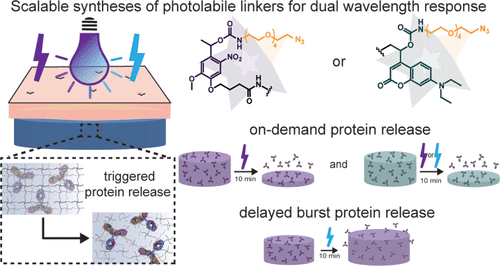当前位置:
X-MOL 学术
›
ACS Appl. Bio Mater.
›
论文详情
Our official English website, www.x-mol.net, welcomes your
feedback! (Note: you will need to create a separate account there.)
On-Demand and Tunable Dual Wavelength Release of Antibodies Using Light-Responsive Hydrogels
ACS Applied Bio Materials ( IF 4.6 ) Pub Date : 2020-09-16 , DOI: 10.1021/acsabm.0c00823 Paige J LeValley 1 , Bryan P Sutherland 2 , Jennifer Jaje 3 , Sandra Gibbs 3 , Mark Jones 3 , Rikhav Gala 3 , Christopher J Kloxin 1, 2 , Kristi L Kiick 2 , April M Kloxin 1, 2
ACS Applied Bio Materials ( IF 4.6 ) Pub Date : 2020-09-16 , DOI: 10.1021/acsabm.0c00823 Paige J LeValley 1 , Bryan P Sutherland 2 , Jennifer Jaje 3 , Sandra Gibbs 3 , Mark Jones 3 , Rikhav Gala 3 , Christopher J Kloxin 1, 2 , Kristi L Kiick 2 , April M Kloxin 1, 2
Affiliation

|
There has been an increased interest in the use of protein therapeutics, especially antibodies, for the treatment of a variety of diseases because of their high specificity to tissues and biological pathways of interest. However, the use of antibodies can be hindered by physical aggregation, degradation, and diffusion when injected in vivo, leading to the need for antibody-releasing depots for the controlled and localized delivery within the tissues of interest. Here, we investigated photolabile hydrogel chemistries for creating on-demand and tunable antibody release profiles. Innovative, scalable synthetic procedures were established and applied for fabricating hydrogels with nitrobenzyl (NB) and coumarin (CMR) photolabile crosslinks that responded to clinically relevant doses of long-wavelength UV and short-wavelength visible light. This synthetic procedure includes a route to make a CMR linker possessing two functional handles at the same ring position with water-stable bonds. The photocleavage properties of NB and CMR crosslinked hydrogels were characterized, as well as their potential for translational studies by degradation through the pig skin, a good human skin mimic. The mechanism of hydrogel degradation, bulk versus surface eroding, was determined to be dependent on the wavelength of light utilized and the molar absorptivity of the different photolabile linkers, providing a facile means for altering protein release upon hydrogel degradation. Further, the encapsulation and on-demand release of a model monoclonal antibody was demonstrated, highlighting the ability to control antibody release from these hydrogels through the application of light, while retaining its bioactivity. In particular, the newly designed CMR hydrogels undergo surface erosion-based protein release using visible light, which is more commonly used clinically. Overall, this work establishes scalable syntheses and relevant pairings of formulation–irradiation conditions for designing on-demand and light-responsive material systems that provide controlled, tunable release of bioactive proteins toward addressing barriers to preclinical translation of light-based materials and ultimately improving therapeutic regimens.
中文翻译:

使用光响应水凝胶按需和可调双波长释放抗体
人们对使用蛋白质疗法(尤其是抗体)治疗各种疾病越来越感兴趣,因为它们对感兴趣的组织和生物途径具有高度特异性。然而,在体内注射时,抗体的使用可能会受到物理聚集、降解和扩散的阻碍,导致需要抗体释放库来在感兴趣的组织内进行受控和局部递送。在这里,我们研究了光不稳定水凝胶化学成分,以创建按需和可调的抗体释放曲线。建立了创新的、可扩展的合成程序,并应用于制造具有硝基苯甲基(NB)和香豆素(CMR)不稳定性交联的水凝胶,该水凝胶对临床相关剂量的长波长紫外线和短波长可见光有反应。该合成程序包括制备 CMR 连接体的路线,该连接体在同一环位置具有两个具有水稳定性键的功能手柄。表征了 NB 和 CMR 交联水凝胶的光裂解特性,以及它们通过猪皮(一种良好的人类皮肤模拟物)降解进行转化研究的潜力。水凝胶降解的机制(体积与表面侵蚀)被确定取决于所用光的波长和不同光不稳定连接体的摩尔吸收率,这提供了一种改变水凝胶降解时蛋白质释放的简便方法。此外,还证明了模型单克隆抗体的封装和按需释放,突出了通过应用光控制抗体从这些水凝胶中释放的能力,同时保留其生物活性。 特别是,新设计的CMR水凝胶利用可见光进行基于表面侵蚀的蛋白质释放,这在临床上更常用。总体而言,这项工作建立了可扩展的合成方法和配方-照射条件的相关配对,用于设计按需和光响应材料系统,提供生物活性蛋白的受控、可调释放,以解决光基材料临床前转化的障碍,并最终改善治疗效果治疗方案。
更新日期:2020-10-21
中文翻译:

使用光响应水凝胶按需和可调双波长释放抗体
人们对使用蛋白质疗法(尤其是抗体)治疗各种疾病越来越感兴趣,因为它们对感兴趣的组织和生物途径具有高度特异性。然而,在体内注射时,抗体的使用可能会受到物理聚集、降解和扩散的阻碍,导致需要抗体释放库来在感兴趣的组织内进行受控和局部递送。在这里,我们研究了光不稳定水凝胶化学成分,以创建按需和可调的抗体释放曲线。建立了创新的、可扩展的合成程序,并应用于制造具有硝基苯甲基(NB)和香豆素(CMR)不稳定性交联的水凝胶,该水凝胶对临床相关剂量的长波长紫外线和短波长可见光有反应。该合成程序包括制备 CMR 连接体的路线,该连接体在同一环位置具有两个具有水稳定性键的功能手柄。表征了 NB 和 CMR 交联水凝胶的光裂解特性,以及它们通过猪皮(一种良好的人类皮肤模拟物)降解进行转化研究的潜力。水凝胶降解的机制(体积与表面侵蚀)被确定取决于所用光的波长和不同光不稳定连接体的摩尔吸收率,这提供了一种改变水凝胶降解时蛋白质释放的简便方法。此外,还证明了模型单克隆抗体的封装和按需释放,突出了通过应用光控制抗体从这些水凝胶中释放的能力,同时保留其生物活性。 特别是,新设计的CMR水凝胶利用可见光进行基于表面侵蚀的蛋白质释放,这在临床上更常用。总体而言,这项工作建立了可扩展的合成方法和配方-照射条件的相关配对,用于设计按需和光响应材料系统,提供生物活性蛋白的受控、可调释放,以解决光基材料临床前转化的障碍,并最终改善治疗效果治疗方案。











































 京公网安备 11010802027423号
京公网安备 11010802027423号